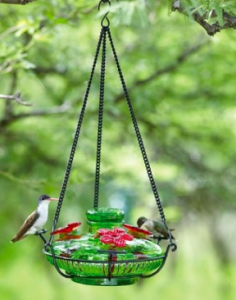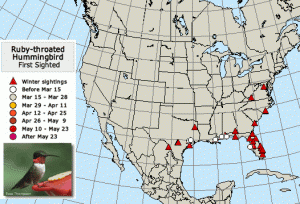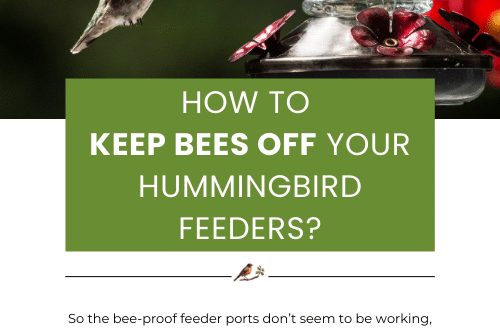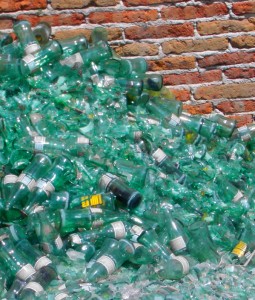-
Boiled Hummingbird Feeders?
In anticipation of the great hummingbird migration, all the hummingbird feeders were pulled from storage last night. With the mild winter season we’ve had in the South, the little sprites may be returning earlier than usual this year. Such an endearing and favorite of all our migratory friends, we roll out the red carpet so to speak!
One of the plastic hummingbird feeders was looking a bit cloudy, although it was cleaned prior to storing last season. While making the first batch of nectar (so simple-recipe below) I had the brilliant idea to pour some of the boiling water in the feeder to “clear it up”. The feeder proceeded to melt in my hand… I couldn’t grasp what was happening at first, until I ended up with a Salvador Dali-looking hummingbird feeder! Really should have taken a picture, but was too disappointed in my better judgement. The feeder’s usable for now, but it sure does look funky.
This is exactly why we prefer blown glass or ceramic hummingbird feeders over plastic ones. The quality just can’t be compared. Instead of buying a new feeder every other season, handcrafted hummingbir
d feeders from artists and companies like Parasol and even BirdBrain will last a lifetime. They can be run through the dishwasher for easy cleaning, and they’ll never turn cloudy or yellow over time. The Dali-looking feeder will now be replaced for the last time with this beauty.
Here’s a map showing the first sightings for Ruby Throats in the South and Southeast, with some who’ve even wintered up North. Brave little guys… it won’t be long now! Find the really easy nectar recipe to fill your hummingbird feeders below, they like it better than commercial mixes too 🙂
Mix 1 cup plain table sugar to 4 cups water. NOTHING ELSE, no substitutes as they may be harmful or even fatal to hummingbirds. Plain, Pure Cane Sugar is the only ingredient to use for nectar. No red dye either, it’s a big myth! There’s no need to boil the water, as any organisms spread are by the hummingbirds’ beaks. We do boil one cup of water, simply to dissolve the sugar more effectively. Let cool, fill feeders, and store unused nectar in the fridge for up to two weeks. That’s it! If you’ve never made your own nectar, we encourage you to try it this season, hummingbirds seem to prefer it, and it will be the least expensive bird food all year!
-
tiny ports on hummingbird feeders… an easy clean
Whether traditional tube style, or basin style, all hummingbird feeders have one thing in common…very tiny feeding ports! These tiny ports tend to build up a “black mold” during summer’s extreme temperatures. Rinsing hummingbird feeders with hot water does not always remove this gunk. Sugar water gets very nasty, even fermenting within just a few days. Hummingbirds will rarely re-visit a feeder that has bad nectar.
To keep your little sprites happy and keep them around for the season, squeaky clean hummingbird feeders and fresh nectar are essential. So just how do you clean those itty-bitty feeding ports? The secret weapon is an old mascara brush! Before tossing your next (or grab your wife’s) mascara, save the brush and run it through the dishwasher to remove all the makeup and residue. These make the perfect cleaning brush for feeder ports on any tube style hummingbird feeders, and basin styles as well.
By the way, if you’re still buying commercial nectar… it’s time to try and make your own. The recipe is so very simple and it takes less than five minutes. Our hummingbirds prefer the plain sugar water, and once we started feeding it, there was a dramatic increase in visitors who stuck around the entire season.
So here’s the recipe to the stuff to fill your hummingbird feeders with: one cup plain table sugar to four cups water. That’s it! Nothing else in the mixture as it will harm or kill hummingbirds. No need to boil the water either, microorganisms are spread through the bird’s bills… not the feeders or nectar. We do boil one cup of water, simply to dissolve the sugar quicker and more effectively. You can then store unused nectar in the fridge for up to two weeks.
So this season, save the mascara brush and try your own nectar!
-
Eco-Friendly Hummingbird Feeders
Recycled Glass Hummingbird Feeders
Blown glass, in the most vibrant of hues is hand crafted by artisans into some of the greatest hummingbird feeders around. The leader in blown glass hummingbird feeders, the company Parasol uses recycled soda bottles for their feeders.
With quality to ensure many years of use and enjoyment, these feeders make wonderful gifts to be used again and again. The newer basin style feeders allow for larger nectar capacity and more hummingbirds to feed at once.
While traditional tube style hummingbird feeders have seen vast improvements to deter dripping and leaky spouts, they are still wildly popular with the tiny flying jewels, also known as hummingbirds. Whichever style feeder, basin or tube, the most important thing is to keep nectar fresh at all times, changing it every few days in warmer weather. It’s really quite simple to make your own nectar too, no red dye needed!
Check out this easy recipe and other hummingbird tips:
Simply use one cup ordinary white cane sugar to four cups water. It’s not necessary to boil the water, but using one cup boiled will dissolve sugar quickly. Add three cups cold water, and nectar is ready for feeders. Store unused sugar water in the refrigerator for up to two weeks. In extreme heat, be sure to change feeders often. Never use honey or syrup as it will ferment and cause hummers harm. Do not use artificial sweeteners.








